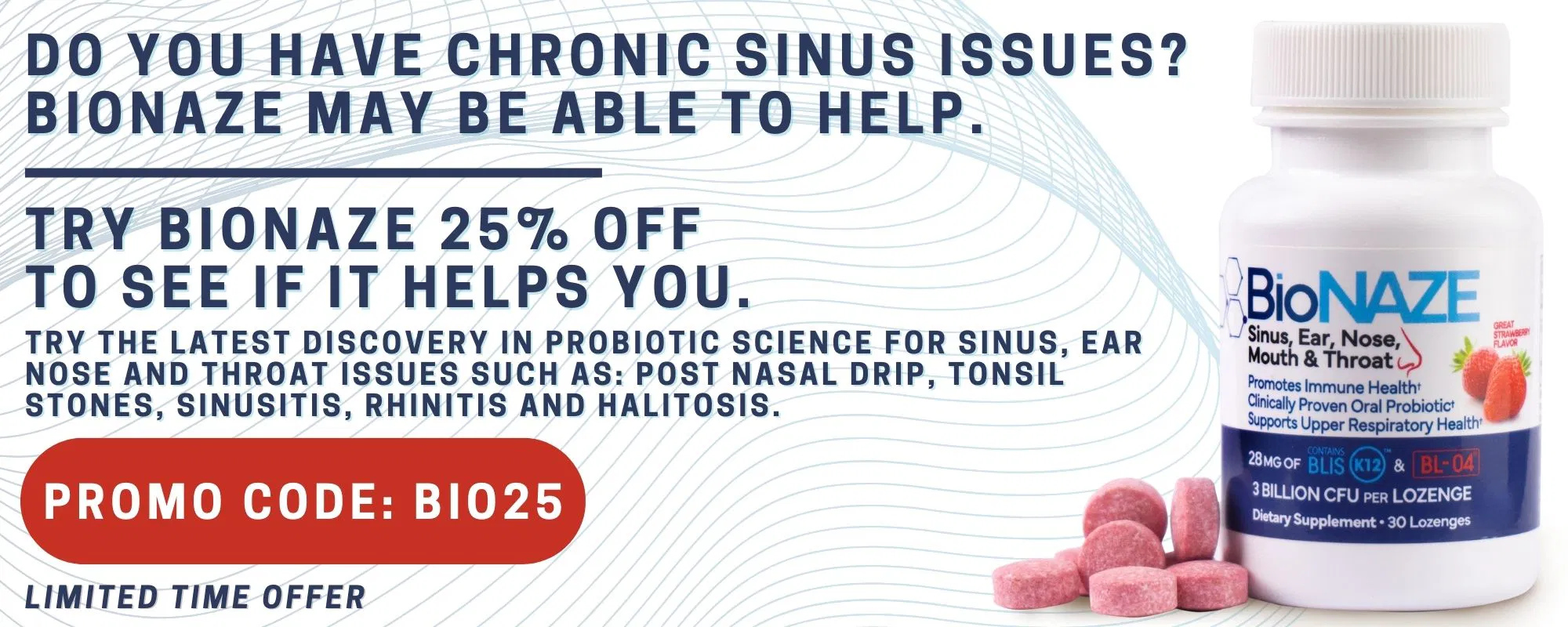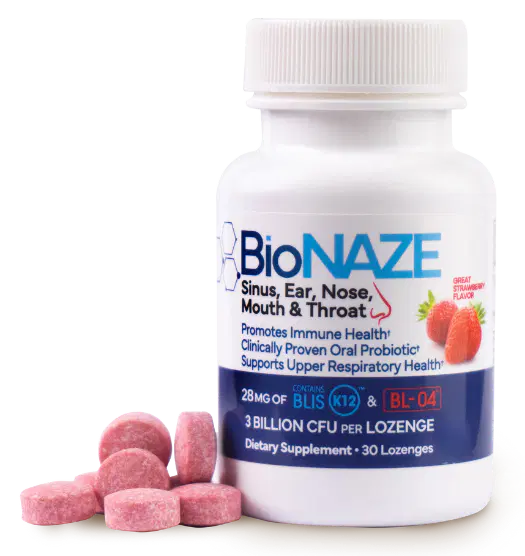Sphenoid Sinus Infection: Causes and Symptoms

Published October 7, 2025
Did you know that some sinus infections can pose serious risks if left untreated? A sphenoid sinus infection, or sphenoid sinusitis, is one such condition. This rare sinus infection occurs deep within the skull. It’s close to vital structures like the brain, eyes, and major nerves. If left untreated, it can result in severe or life-threatening complications.
In this article, we’ll explore sphenoid sinus infections—their causes, symptoms, diagnosis, treatment, and prevention—to help you pinpoint the signs and seek timely medical care.
What Is The Sphenoid Sinus?
The sphenoid sinuses are two air-filled cavities located deep in the skull, behind the nose and between the eyes. Unlike the more familiar frontal or maxillary sinuses, they cannot be felt by pressing on the face.
Like the paranasal sinuses, the sphenoid sinuses produce mucus. This mucus moisturizes nasal passages, humidifies inhaled air, and traps dust and pollutants. They’re located close to critical structures. These include the optic nerves, pituitary gland, and carotid arteries. They’re also near several cranial nerves. Because of their location, infections in this area can be dangerous.
Causes And Risk Factors Of Sphenoid Sinus Infection
Several factors can inflame and block the sphenoid sinuses, leading to an infection.
- Infectious agents: Viruses, bacteria, or fungi can trigger infection. A viral cold can cause inflammation, allowing bacteria to grow. Fungal infections, though less common, may form a “fungal ball” inside the sinus.
- Anatomical predispositions: Narrow drainage pathways can block mucus flow. A deviated septum can also block mucus flow. This blockage creates an environment for infection.
- Preexisting conditions: Chronic allergies, rhinosinusitis, or a weakened immune system increase vulnerability.
- Triggers and aggravating factors: Cigarette smoke, air pollution, and upper respiratory infections can irritate the sinus lining and worsen inflammation.
Sphenoid Sinus Infection Symptoms
Sphenoid sinus infections often cause unusual symptoms because of their deep skull location, making them easy to mistake for other conditions.
Typical Symptoms
- A persistent, deep headache that’s typically felt at the top of the head, behind the forehead, or between the eyes. This headache usually intensifies when bending forward due to increased pressure in the sphenoid sinuses.
- Neck pain or stiffness
- Pain or pressure behind the eyes
- Earache
- Postnasal drip, potentially leading to a sore throat or cough
- Loss of smell (anosmia)
Atypical Presentations
In cases of isolated sphenoid sinusitis, individuals may have a long-lasting, dull headache that’s not relieved by regular pain medications. Because this headache is persistent and resistant to treatment, it can be mistaken for another condition.
Red Flags (Seek Immediate Medical Attention)
- Facial swelling, especially around the eyes
- Vision changes (blurred or double vision)
- Neurological signs such as confusion, drowsiness, or muscle weakness

Diagnosis
Accurate diagnosis of sphenoid sinusitis is challenging, as its symptoms mimic many other conditions and require thorough evaluation.
- Clinical exam and nasal endoscopy: An ENT specialist examines nasal passages with an endoscope to look for inflammation or blockages.
- Imaging studies: A CT scan provides detailed sinus images to confirm inflammation or blockage. MRI may be used if the spread of infection is suspected.
- Laboratory tests: If drainage is present, a culture may identify the exact bacteria or fungus involved.
- Differential diagnoses: Doctors must first rule out other conditions. These can include migraines, cluster headaches, or other types of sinusitis. This process is necessary before they can confirm a sphenoid sinusitis diagnosis.
Complications And Dangers
Untreated sphenoid sinus infections pose a high risk due to their proximity to the brain and major nerves.
- Intracranial Spread: Infection may extend into the brain, causing meningitis or a brain abscess.
- Cranial Nerve Involvement: May cause double vision, drooping eyelids, or facial numbness.
- Cavernous Sinus Thrombosis: A rare but life-threatening clot near the sinus that can lead to stroke or death.
Sphenoid Sinus Infection Treatment
Sphenoid sinusitis treatment depends on the cause and severity of the infection. The goal is to reduce inflammation, clear the blockage, and eradicate the infectious agent.
Medical / Non-Surgical Treatments
- Decongestants and Antihistamines: Over-the-counter decongestants help reduce nasal swelling. Antihistamines are useful if allergies contribute to the infection.
- Nasal Irrigation: Saline sprays and neti pots rinse the nasal passages. They thin mucus, remove irritants, and moisturize the sinuses.
- Antibiotics: If a bacterial infection is likely, antibiotics are prescribed. Always complete the full course as directed by your doctor.
Surgical / Interventional Treatments
- Endoscopic Sinus Surgery: For chronic or severe cases, an ENT surgeon uses an endoscope. This surgery widens sinus drainage pathways. It also removes infected material or fungal masses.
Supportive And Complementary Therapies
- Rest and Hydration: Plenty of rest and fluids help your body fight infection.
- Humidification: A humidifier or steam inhalation can soothe nasal passages and thin mucus.
- Probiotics: Some research suggests certain oral probiotics support upper respiratory health by balancing bacteria in the ear, nose, and throat. Bionaze, which contains the clinically studied strains BLIS K12™ (Streptococcus salivarius K12) and BL-04™ (Bifidobacterium Lactis BL-04), is specially formulated for this purpose and may help prevent chronic sinus, mouth, and gum issues.
Recovery Time And Outlook
With proper treatment, symptoms of acute sphenoid sinusitis usually improve within a few days. The condition should fully resolve within three weeks. Chronic cases, lasting over 12 weeks, may need more extensive treatment, including surgery, and recovery can be slower.
Timely diagnosis and treatment lead to an excellent prognosis. However, if complications arise, the outlook worsens considerably. Following your doctor’s treatment plan is crucial for a full recovery. Attending all follow-up appointments is also important.

Prevention And Self-Care Tips
Preventing sphenoid sinus infection often involves a proactive approach to your health. Adding these preventative measures to your routine can greatly reduce your risk of sinus infection:
- Nasal Hygiene: Use saline sprays regularly to keep nasal passages moist and clear of irritants.
- Avoid Irritants: Steer clear of cigarette smoke and minimize exposure to air pollution and chemical fumes.
- Manage Conditions: Work with your doctor to control allergies or chronic rhinosinusitis.
- Early Treatment: Promptly treat upper respiratory infections to prevent secondary bacterial infections.
When To Seek Emergency Care
Seek urgent medical attention if you experience:
- A sudden, severe headache, especially with a fever
- A stiff neck
- Vision changes, such as blurriness, double vision, or eye swelling
- Confusion, unusual drowsiness, or changes in mental state
- Facial numbness or weakness
These may indicate the infection has spread to nearby brain or nerve structures.
Frequently Asked Questions
How long does a sphenoid sinus infection last?
Acute infections typically clear within three weeks; chronic cases may last longer than 12 weeks.
What does sphenoid sinus pain feel like?
Pain often feels like a deep, persistent ache behind the eyes, forehead, or top of the head, sometimes radiating to the neck or ears.
Can a sphenoid sinus infection affect vision?
Yes. The sinus lies close to the optic nerves, so swelling or infection can cause blurred or double vision — seek care immediately if this occurs.
Can a sphenoid sinus infection go away on its own?
Mild viral sinusitis might resolve on its own. However, a suspected sphenoid infection needs a prompt medical evaluation. This is due to the risk of serious complications.
Why Choose Bionaze
Recovering from a sphenoid sinus infection is about more than just treatment. It’s about maintaining long-term sinus and respiratory health. Bionaze, an oral probiotic supplement with clinically researched strains BLIS K12™ (Streptococcus salivarius K12) and BL-04™ (Bifidobacterium Lactis BL-04), is formulated to support this balance.
Typical probiotics focus on gut health. Bionaze is different. It targets the sinus, ear, nose, throat, mouth, gum, and teeth. These areas are directly linked to sphenoid sinus wellness.
How Bionaze helps:
- Promotes sinus and nasal balance, easing inflammation and congestion.
- Reduces recurrence of sinus and throat infections that can aggravate sphenoid sinusitis.
- Supports immune health, helping your body maintain lasting respiratory protection.
Consider making Bionaze a part of your daily routine. This natural approach supports recovery and helps prevent future sinus issues, so you can maintain better breathing and well-being every day.

Take Action Early: Protect Your Sinus And Overall Health
Sphenoid sinus infections are rare but potentially serious. Their deep location and subtle symptoms make them easy to overlook. Early diagnosis and proper treatment are vital. This prevents dangerous complications. If you have persistent, unexplained headaches or vision changes, don’t ignore the signs. Consult a medical professional for prompt evaluation and care — your health depends on it.
Take control of your sinus and ENT health naturally. Choose Bionaze, an oral probiotic formulated to help prevent chronic issues in your sinuses, ears, nose, throat, mouth, gums, and teeth. Support your body’s natural defenses today for fewer infections tomorrow.
Benefit From The Latest Advancements In Probiotic Science With Bionaze
Bionaze is a proprietary blend of probiotics proven to promote ear, nose, and throat health, improve digestion, and support your immune system. The active ingredients BLIS K12, and BL-04 are considered among the best probiotics according to science.
Get 25% Off Your First Order when you use BIO25 at checkout!

This Content Has Been Reviewed For Factual Accuracy
This content has undergone thorough fact-checking by our team of internal experts. Learn more about the meticulous editorial standard for our website here.
ADVERTISEMENT

About The Author
Hi, I’m Corinne Grace, a proud nursing graduate from Riverside College with a flair for writing. I specialize in health and wellness topics, using my educational background to weave informative and attention-grabbing articles that appeal to a wide variety of readers. Committed to excellence in writing, I’m always refining my skills to stay in sync with the fast-evolving world of digital media. Whether you’re seeking to understand complex health concepts or looking for relatable advice, I’m here to deliver content that’s accurate and enjoyable to read.




